|
MESSAGE FROM THE OWNER
Marketing
Why the right name matters
Names are communication shortcuts (clues) that allow our brains to quickly form mental images. If the name is well chosen, it allows potential buyers of your meat, eggs, fiber, breeding animals, vegetables, etc. to instantly differentiate your product and/or business from others.
Consider, for example, a breakfast menu with the simple, unadorned word/name "Eggs" on it. You wouldn't order them without more information, would you? Why? Because the name doesn't allow our brain to form a useful mental image -- there are very different possibilities for a breakfast egg. That's why useful menus add descriptive words like scrambled, fried or poached that instantly clarify for each of us how the eggs will appear on our plate.
But what if the menu said "Aunt Lucy's Farm-Fresh Scrambled Eggs"? What does that name tell you? 1) That they will look and taste like scrambled eggs; and 2) that the eggs didn't come from a vast egg factory. Instead, the enhanced name suggests that it probably came from a local producer who cares a bit more about taste and freshness than some others.
Once the name provides enough instant clues, our brain is then likely to pay attention to more detail about Aunt Lucy's eggs: i.e. prepared with herbs and spices, served with toast, etc. Result? A breakfast buyer agrees to spend extra coins for a superior (due to the name and description) eating experience.
But the product must match the name and the description. If the scrambled eggs that arrive are tasteless and boring, then it's likely the restaurant won't be selling many of Aunt Lucy's eggs. And it's the same story if the eating experience is inconsistent (good one day, bad the next), particularly if the cost of the meal is higher than the norm. It's critical that the name and the product support each other.
The other day my wife and I had lunch at a small restaurant in nearby Kalona, IA. It offered three herb-encrusted lamb cutlets (no other description) as an appetizer for $14. For this area that's very expensive, but we ordered one serving for the two of us. Why? Because 1) I raise sheep; and 2) we had the same appetizer at the same restaurant eight months ago--expensive but very tasty. We were pleased to find these lamb cutlets to be as good as the first ones.
So I asked the restaurant owner about the source of the lamb. It came from New Zealand. Now I think the owner was clever in choosing not to have his menu say "New Zealand Herb-Encrusted Lamb," because a percentage of customers might be concerned about the flavor or freshness of lamb grown and killed 11,000 miles away--and thus not pay the high price. And many of us have patriotic inclinations.
However, if the lamb had been local (and just as good), I don't doubt that the name and descriptive copy might instead read "Herb-Encrusted Lamb from Larry Green's Sheep Farm of Kalona, IA." That the source was local would add interest, potential freshness and a sense of benefit for the community. And the personal name "Larry Green" also adds potential value. Why? When a local producer is willing to attach his/her name to an item, then a sense of enhanced responsibility for the result is assumed by potential buyers. And that's why the right name is important.
Best wishes to you all,
Stan Potratz, Owner
GOAT UPDATE
American Goat Federation
News Update
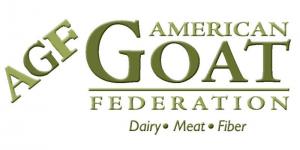
Scottsdale, AZ - The American Goat Federation (AGF) held its annual Board of Directors and membership meeting on January 28 in Scottsdale, AZ. The main agenda item was the development of a comprehensive strategic plan for meeting member needs as well as representing the entire U.S. goat industry at the national level. Working groups were formed to focus on organizational marketing and member services; goat production, research and education; public policy; and communication outreach.
Following an election of new board members in December, the current AGF board composition reflects representation of all segments of the industry: Sam Abney (AL), Tom Boyer (UT), Steve Burton (UT), Linda Campbell (VA), Jan Carlson (CA), Anita Teel Dahnke (IN), Dr. Gil R. Engdahl (TX), Dr. Will R. Getz (GA), Pierce Miller (TX), Mary Pryde (CA), Robin Saum (OH), and Boyd Willoughby (UT). Newly elected AGF Board officers include Tom Boyer, President; Linda Campbell, Vice President; Mary Pryde, Secretary; and Pierce Miller, Treasurer.
The American Goat Federation is a national organization developed to represent and speak with one voice for all segments of the goat industry, including meat, dairy and fiber. Major goals include the unification, improvement, and advancement of all sectors of the U.S. goat industry; as well as maximizing the potential for growth; and assisting producers to achieve success on the farm as well as in the market place. There are more than 100 organizations and thousands of producers engaged in the sustainable production and marketing of goat milk, meat, fiber and grazing services across the United States. The Federation seeks to enhance growth of the industry by not only representing all areas of production within the industry, but also by being a central clearinghouse for reliable information about the industry and all issues affecting its members.
For more information, please contact:
Steve Lee | (202) 350-9065
SteveLee@AmericanGoatFederation.org
Tom Boyer | (801) 376-4685
TomBoyer@AmericanGoatFederation.org
More information is available at AmericanGoatFederation.org.
COMING SOON
2012 "Fences that Work!" Catalog
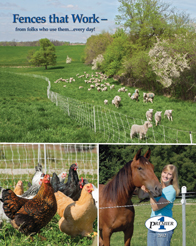
Premier's new 2012 "Fences that Work!" catalog will be mailed in March. Watch for it in your mailbox.
The 152-page catalog that is more of a "how-to" booklet than a catalog. No other agricultural supply source devotes so much effort to ensure that you know what's involved before you place an order.
PREMIER TIP
Creep Feeding
When you are lambing in a barn and want to set up a creep feeding area, hang a Premier Heat Lamp with a 175 Watt Bulb hanging over the pen. The light and heat it provides will attract the lambs to the creep feeding area and they will begin to eat creep feed. When building a creep feeding area, use a Creep Gate to prevent ewes from eating the lambs' feed.
Starting a lamb as soon as possible on dry feed will help produce the most $$ per lamb.
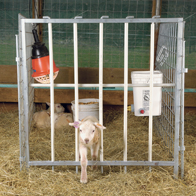
Bucket Teat Unit (shown in photo) is used for providing orphan lambs with a source of milk.
- by Gordon Shelangoski, Premier Product Consultant
View more Lambing and Kidding Supplies.
VIP ARTICLE
Creep Feeding Primer
By Susan Schoenian
University of Maryland Extension
sheepandgoat.com
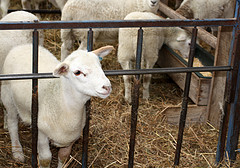
Creep feeding is a means of providing supplemental nutrition to nursing lambs and kids. It is accomplished by giving lambs and kids access to extra feed or better pasture, while excluding their dams.
Lambs and kids that are born in the winter months are often creep fed, since pasture is usually not readily available. Show animals are typically creep fed, in order to get them bigger for show.
Creep feeding is recommended for accelerated lambing and kidding programs, in flocks and herds where there are a lot of multiple births, and anytime milk production is a limiting factor. Artificially-reared lambs and kids should probably be creep fed. Creep feeding is also advisable when pasture quality or quantity is lacking.
Lambs and kids that are creep-fed will almost always grow faster than those that are not, especially if grain is the source of supplemental nutrition. Faster growth means lambs and kids can be marketed younger and sooner, often in time for high demand periods (e.g. Orthodox Easter).
Creep feeding teaches young animals to eat. It reduces the stress of early weaning. The rumens of creep-fed lambs and kids will develop faster. I've seen three week old lambs chewing their cuds. It is always more economical to feed lambs and kids than does and ewes. A young lamb or kid converts feed to gain very efficiently. The extra nutrition (especially protein) may help to improve tolerance to internal parasites.
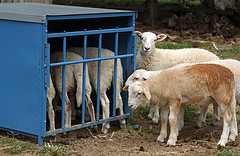
Waiting their turn Creep feeding does not need to be complicated. A "creep area" may be set up in the barn or out on pasture. The creep barrier needs to be big enough for lambs to fit through, but small enough to keep even the smallest ewe out. A tire can be used as a creep barrier. Some gates have big enough openings that kid goats can slip through. The creep area should be clean and well-bedded, an area where the lambs and kids will like to go.
Creep feed may be fed in troughs or self-feeders. Good creep feeders don't allow lambs or kids to play on (or in) or put their feet in the feeders. Creep rations don't need to be complicated -- just fresh, palatable, always available, and highly digestible. Typical feed ingredients are ground or cracked corn, alfalfa hay or meal, soybean meal, oats, and molasses. The percent protein in the creep ration should be at least 14 to 18. The protein should be all-natural (no urea).
It is recommended that lambs and kids be introduced to creep feed early in life, ideally by the time they are 10 days old. You can make your own creep ration or purchase a commercial product. On my farm, I start with a mixture of soybean meal, cracked corn, and minerals. Some producers use straight soybean meal for their creep starter or top-dress their creep ration with it. Soybean meal is very palatable to young lambs and kids. As my lambs get older and begin chewing their cuds, I gradually switch their creep ration to whole barley and a pelleted protein supplement.
When lambs are young, feeds with a small particle size are more palatable to them. As they get older, they prefer coarser feeds and are able to digest whole grains very efficiently. The protein content of the ration can be reduced as the lambs get older.
Eating Creep Feed
For disease prevention, it is a good idea to include a coccidiostat (Bovatec®, Rumensin®, or Deccox®) and urine acidifier (e.g. ammonium chloride) in the creep ration. The ratio of calcium to phosphorus should be at least 2:1 to prevent urinary calculi in male lambs and kids.
Creep-fed lambs and kids are more susceptible to enterotoxemia, "classical" overeating disease (clostridium perfringins type D). Their dams should be vaccinated approximately one month before parturition. Lambs and kids should be vaccinated after their colostrial immunity wanes, at approximately 6-8 and 10-12 weeks of age.
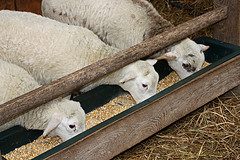
Lambs and kids from unvaccinated dams should receive their first vaccination for overeating disease when they approximately four weeks old, followed by a booster four weeks later. Earlier vaccines are not likely to be effective due to the immature immune system of young lambs and kids and interference of the maternal antibodies. Overeating disease most commonly affects the fastest growing lambs and kids, usually past a month of age.
Creep feeding is a common practice in the sheep and goat industry. All producers need to evaluate the appropriateness of the practice for their production and marketing systems. For creep feeding to be economical, the higher value (extra weight and higher prices) of creep-fed lambs and kids needs to exceed the cost of the creep feed. Creep feeding may not always be economical, especially on farms with high quality forage. Creep feeding is more likely to be cost-effective with lambs than goats.
EMPLOYEE SPOTLIGHT
Brenda McArtor
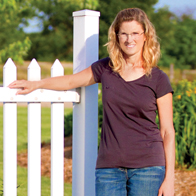 |
Brenda has been with Premier for 15 years and is our Sales/Assistant Operations Manager. What she likes best about her position is talking to the customers and trying to find the best product for their needs. She also enjoys meeting people from all over the USA and Canada and hearing about the unique backgrounds they come from.
Overall her favorite part about Premier is the values that the owners, Stan and Jean, have set forth: "treat the customers right, make sure the product is good and reliable."
Brenda and her husband Larry have been married for 28 years. They live on the farm that Larry grew up on. Most of their ground is rented out but they still raise a few cattle.
Brenda and Larry have two daughters. Jamie and her husband Chris live in North English, IA. They have blessed Brenda and Larry with two grandchildren, Kaden (8) and Delaney (6). Brenda's youngest daughter, Kylie, recently graduated from the University of Iowa. She is currently working in a research lab for the University of Iowa Hospital. Brenda and Larry have recently adopted a stray dog named Lillie. It did not take long for Lillie to make her way into the hearts of the McArtors.
As a family, the McArtor's enjoy camping, bike riding and boating. Each year they spend time as a family at the Iowa State Fair and take a yearly camping trip.
Brenda's favorite statement is, 'I may be beat up, but I am not beaten." Her philosophy is; life may deal some pretty hard blows, but there is always some one dealing with worse. If everyone would try to make the world a little better and be a little kinder, it just might be. Brenda is certainly doing her part to make the world a better place around her, and we appreciate her for it.
|